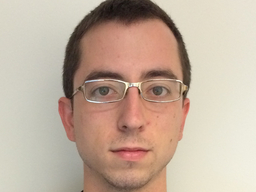PhD Defense: Jaron Kropp
Location
Off Campus : via Webex
Date & Time
April 23, 2020, 10:00 am – 12:00 pm
Description
ADVISOR: Dr. Theodosia Gougousi
CO-ADVISOR: Dr. Can Ataca
TITLE: Investigations of Two-Dimensional Materials for Next-Generation Electronic Devices
ABSTRACT: Semiconducting transition metal dichalcogenides (TMDs) such as MoS2 exhibit a direct band gap when isolated in monolayer form. They also exhibit high carrier mobility and are therefore attractive for use as channel materials in metal-oxide semiconductor field-effect transistors (MOSFETs) and other devices. MOSFETs rely on the integration of a metal-oxide dielectric layer with the semiconducting channel material. Atomic layer deposition (ALD) is often used for the deposition of dielectrics, but the MoS2 surface is hydrophobic and lacks dangling bonds. Because of this, ALD films on MoS2 are often poor quality, containing many gaps or pinholes.
This work studies the effects of MoS2 surface preparation on ALD film quality. ALD films of TiO2 and Al2O3 are deposited on both mechanically exfoliated and chemical vapor deposition (CVD) grown MoS2. It is found that mechanically exfoliated MoS2 samples exhibit a wide range of film surface coverage as a result of variations in surface defect concentration and contamination from the exfoliation process. CVD-grown MoS2 offers more reliable starting surfaces. Therefore, CVD-grown MoS2 was chosen to study surface engineering and functionalization for ALD.
Reactive sulfur vacancies were formed in the MoS2 surface via argon ion sputtering, and thiol molecules were introduced to passivate the vacancies and leave the surface amenable to ALD. Films grown on thiol-treated surfaces and vacancy-containing surfaces were continuous and morphologically similar. DFT calculations showed that the thiol molecules attach primarily to sulfur vacancies. The ALD precursor molecule also binds strongly to the sulfur vacancies, thus leading to uniform film growth on vacancy-containing surfaces.
The remainder of this work focuses on the discovery of novel electronic materials using DFT. The electronic and magnetic properties of Janus TMD nanoribbons were studied. Janus TMDs are created by replacing one side of chalcogen atoms (e.g. S) of a TMD monolayer with another (e.g. Se). Nanoribbons of Mo- and W-based Janus TMDs were studied in zigzag and armchair configurations. Zigzag nanoribbons are found to be magnetic metals, while armchair nanoribbons are semiconductors. The magnetic and electronic properties of these nanoribbons can be modulated by controlling the ribbon width and the saturation of edge atoms.
Further studies investigate the surface functionalization of two-dimensional tellurene (Te). DFT is used to investigate the electronic structure of α- and β-Te sheets functionalized with hydrogen, oxygen, or fluorine. When functionalized, α- and β-Te become metallic, except for hydrogenated β-Te which remains semiconducting. Fluorinated Te structures are unstable, but H and O functionalized structures may be suitable for use in nanoscale electronics.
Defense will be held using Webex.
CO-ADVISOR: Dr. Can Ataca
TITLE: Investigations of Two-Dimensional Materials for Next-Generation Electronic Devices
ABSTRACT: Semiconducting transition metal dichalcogenides (TMDs) such as MoS2 exhibit a direct band gap when isolated in monolayer form. They also exhibit high carrier mobility and are therefore attractive for use as channel materials in metal-oxide semiconductor field-effect transistors (MOSFETs) and other devices. MOSFETs rely on the integration of a metal-oxide dielectric layer with the semiconducting channel material. Atomic layer deposition (ALD) is often used for the deposition of dielectrics, but the MoS2 surface is hydrophobic and lacks dangling bonds. Because of this, ALD films on MoS2 are often poor quality, containing many gaps or pinholes.
This work studies the effects of MoS2 surface preparation on ALD film quality. ALD films of TiO2 and Al2O3 are deposited on both mechanically exfoliated and chemical vapor deposition (CVD) grown MoS2. It is found that mechanically exfoliated MoS2 samples exhibit a wide range of film surface coverage as a result of variations in surface defect concentration and contamination from the exfoliation process. CVD-grown MoS2 offers more reliable starting surfaces. Therefore, CVD-grown MoS2 was chosen to study surface engineering and functionalization for ALD.
Reactive sulfur vacancies were formed in the MoS2 surface via argon ion sputtering, and thiol molecules were introduced to passivate the vacancies and leave the surface amenable to ALD. Films grown on thiol-treated surfaces and vacancy-containing surfaces were continuous and morphologically similar. DFT calculations showed that the thiol molecules attach primarily to sulfur vacancies. The ALD precursor molecule also binds strongly to the sulfur vacancies, thus leading to uniform film growth on vacancy-containing surfaces.
The remainder of this work focuses on the discovery of novel electronic materials using DFT. The electronic and magnetic properties of Janus TMD nanoribbons were studied. Janus TMDs are created by replacing one side of chalcogen atoms (e.g. S) of a TMD monolayer with another (e.g. Se). Nanoribbons of Mo- and W-based Janus TMDs were studied in zigzag and armchair configurations. Zigzag nanoribbons are found to be magnetic metals, while armchair nanoribbons are semiconductors. The magnetic and electronic properties of these nanoribbons can be modulated by controlling the ribbon width and the saturation of edge atoms.
Further studies investigate the surface functionalization of two-dimensional tellurene (Te). DFT is used to investigate the electronic structure of α- and β-Te sheets functionalized with hydrogen, oxygen, or fluorine. When functionalized, α- and β-Te become metallic, except for hydrogenated β-Te which remains semiconducting. Fluorinated Te structures are unstable, but H and O functionalized structures may be suitable for use in nanoscale electronics.
Defense will be held using Webex.
